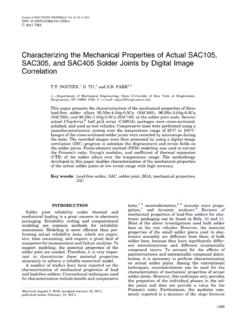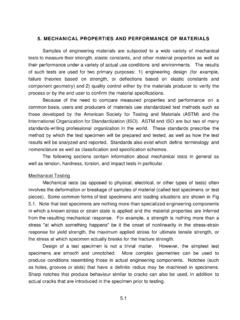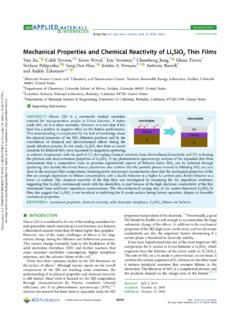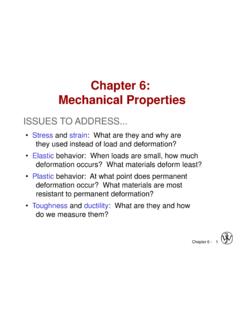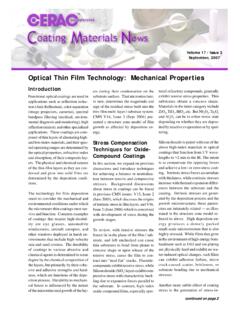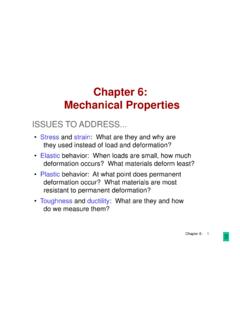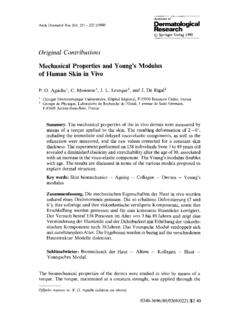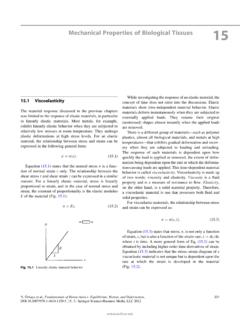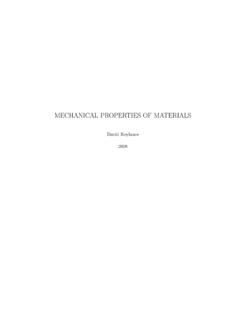Transcription of Wood Handbook, Chapter 05: Mechanical Properties of Wood
1 Chapter 5 Mechanical Properties of WoodDavid E. Kretschmann, Research General Engineer5 1 The Mechanical Properties presented in this Chapter were obtained from tests of pieces of wood termed clear and straight grained because they did not contain characteris-tics such as knots, cross grain, checks, and splits. These test pieces did have anatomical characteristics such as growth rings that occurred in consistent patterns within each piece. Clear wood specimens are usually considered homoge-neous in wood of the Mechanical Properties of wood tabulated in this Chapter were derived from extensive sampling and analysis procedures. These Properties are represented as the aver-age Mechanical Properties of the species. Some Properties , such as tension parallel to the grain, and all Properties for some imported species are based on a more limited number of specimens that were not subjected to the same sampling and analysis procedures.
2 The appropriateness of these latter Properties to represent the average Properties of a species is uncertain; nevertheless, the Properties represent the best information , or variation in Properties , is common to all materials. Because wood is a natural material and the tree is subject to many constantly changing influences (such as moisture, soil conditions, and growing space), wood proper-ties vary considerably, even in clear material. This Chapter provides information, where possible, on the nature and magnitude of variability in Chapter also includes a discussion of the effect of growth features, such as knots and slope of grain, on clear wood Properties . The effects of manufacturing and service environments on Mechanical Properties are discussed, and their effects on clear wood and material containing growth features are compared. Chapter 7 discusses how these research results have been implemented in engineering Nature of WoodWood may be described as an orthotropic material; that is, it has unique and independent Mechanical Properties in the directions of three mutually perpendicular axes: longitudi-nal, radial, and tangential.
3 The longitudinal axis L is parallel to the fiber (grain); the radial axis R is normal to the growth rings (perpendicular to the grain in the radial direction); and the tangential axis T is perpendicular to the grain but tangent to the growth rings. These axes are shown in Figure 5 Orthotropic Nature of Wood 5 1 Elastic Properties 5 2 Modulus of Elasticity 5 2 Poisson s Ratio 5 2 Modulus of Rigidity 5 3 Strength Properties 5 3 Common Properties 5 3 Less Common Properties 5 15 Vibration Properties 5 17 Speed of Sound 5 17 Internal Friction 5 17 Mechanical Properties of Clear Straight-Grained Wood 5 21 Natural Characteristics Affecting Mechanical Properties 5 26 Specific Gravity 5 26 Knots 5 26 Slope of Grain 5 28 Annual Ring Orientation 5 31 Reaction Wood 5 31 Juvenile Wood 5 32 Compression Failures 5 33 Pitch Pockets 5 33 Bird Peck 5 33 Extractives 5 34 Properties of Timber from Dead Trees 5 34 Effects of Manufacturing and Service Environments
4 5 34 Temperature 5 35 Time Under Load 5 38 Aging 5 41 Exposure to Chemicals 5 41 Chemical Treatment 5 41 Nuclear Radiation 5 43 Mold and Stain Fungi 5 43 Decay 5 43 Insect Damage 5 44 Literature Cited 5 44 Additional References 5 445 2 Elastic PropertiesTwelve constants (nine are independent) are needed to de-scribe the elastic behavior of wood: three moduli of elastic-ity E, three moduli of rigidity G, and six Poisson s ratios . The moduli of elasticity and Poisson s ratios are related by expressions of the form (5 1)General relations between stress and strain for a homoge-neous orthotropic material can be found in texts on anisotropic of ElasticityElasticity implies that deformations produced by low stress are completely recoverable after loads are removed. When loaded to higher stress levels, plastic deformation or failure occurs.
5 The three moduli of elasticity, which are denoted by EL, ER, and ET, respectively, are the elastic moduli along the longitudinal, radial, and tangential axes of wood. These moduli are usually obtained from compression tests; how-ever, data for ER and ET are not extensive. Average values of ER and ET for samples from a few species are presented in Table 5 1 as ratios with EL; the Poisson s ratios are shown in Table 5 2. The elastic ratios, and the elastic constants themselves, vary within and between species and with mois-ture content and specific modulus of elasticity determined from bending, EL, rather than from an axial test, may be the only modulus of elasticity available for a species. Average EL values obtained from bending tests are given in Tables 5 3 to 5 5. Repre-sentative coefficients of variation of EL determined with bending tests for clear wood are reported in Table 5 6.
6 As tabulated, EL includes an effect of shear deflection; EL from bending can be increased by 10% to remove this effect ap-proximately. This adjusted bending EL can be used to deter-mine ER and ET based on the ratios in Table 5 s RatioWhen a member is loaded axially, the deformation perpen-dicular to the direction of the load is proportional to the deformation parallel to the direction of the load. The ratio of the transverse to axial strain is called Poisson s ratio. The Poisson s ratios are denoted by LR, RL, LT, TL, RT, and TR. The first letter of the subscript refers to direction of applied stress and the second letter to direction of lateral deformation. For example, LR is the Poisson s ratio for deformation along the radial axis caused by stress along the longitudinal axis. Average values of experimentally de-termined Poisson s ratios for samples of a few species are given in Table 5 2.
7 The ideal relationship between Poisson s ratio and the moduli of elasticity given in Equation (5 1) are not always closely met. Two of the Poisson s ratios, RL and TL, are very small and are less precisely determined than are those for other Poisson s ratios. Poisson s ratios vary within and between species and are affected by moisture content and specific 5 1. Three principal axes of wood with respect to grain direction and growth 5 1. Elastic ratios for various species at approximately 12% moisture contentaSpecies ET/ELER/ELGLR/ELGLT/ELGRT/ELHardwoodsAsh , white Balsa Birch, yellow , black Cottonwood, eastern Mahogany, African , Honduras , sugar Maple, red Oak, red Oak, white Sweetgum , black , northern white , western red , subalpine , western.
8 Western white , Sitka , Engelmann may be approximated by increasing modulus of elasticity values in Table 5 3 by 10%. General Technical Report FPL GTR 1905 3 Chapter 5 Mechanical Properties of WoodModulus of RigidityThe modulus of rigidity, also called shear modulus, indi-cates the resistance to deflection of a member caused by shear stresses. The three moduli of rigidity denoted by GLR, GLT, and GRT are the elastic constants in the LR, LT, and RT planes, respectively. For example, GLR is the modulus of rigidity based on shear strain in the LR plane and shear stresses in the LT and RT planes. Average values of shear moduli for samples of a few species expressed as ratios with EL are given in Table 5 1.
9 As with moduli of elasticity, the moduli of rigidity vary within and between species and with moisture content and specific PropertiesCommon PropertiesMechanical Properties most commonly measured and repre-sented as strength Properties for design include modulus of rupture in bending, maximum stress in compression par-allel to grain, compressive stress perpendicular to grain, and shear strength parallel to grain. Additional measurements are often made to evaluate work to maximum load in bend-ing, impact bending strength, tensile strength perpendicular to grain, and hardness. These Properties , grouped according to the broad forest tree categories of hardwood and soft-wood (not correlated with hardness or softness), are given in Tables 5 3 to 5 5 for many of the commercially important species. Average coefficients of variation for these proper-ties from a limited sampling of specimens are reported in Table 5 of rupture Reflects the maximum load-carrying capacity of a member in bending and is proportional to max-imum moment borne by the specimen.
10 Modulus of rupture is an accepted criterion of strength, although it is not a true stress because the formula by which it is computed is valid only to the elastic to maximum load in bending Ability to absorb shock with some permanent deformation and more or less injury to a specimen. Work to maximum load is a measure of the combined strength and toughness of wood under bending strength parallel to grain Maximum stress sustained by a compression parallel-to-grain specimen hav-ing a ratio of length to least dimension of less than stress perpendicular to grain Reported as stress at proportional limit. There is no clearly defined ulti-mate stress for this strength parallel to grain Ability to resist internal slipping of one part upon another along the grain. Values presented are average strength in radial and tangential shear bending In the impact bending test, a hammer of given weight is dropped upon a beam from successively in-creased heights until rupture occurs or the beam deflects 152 mm (6 in.)
